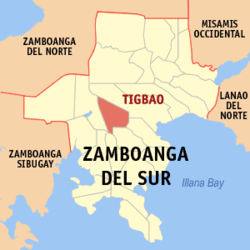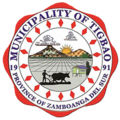Tigbao | |
|---|---|
| Municipality of Tigbao | |
| Motto: "Usbaw Tigbao" | |
 Map of Zamboanga del Sur with Tigbao highlighted | |
Location within the Philippines | |
| Coordinates: 7°49′14″N123°13′40″E / 7.82052778°N 123.22766389°E | |
| Country | Philippines |
| Region | Zamboanga Peninsula |
| Province | Zamboanga del Sur |
| District | 2nd district |
| Founded | November 8, 1991 |
| Barangays | 18 (see Barangays) |
| Government | |
| • Type | Sangguniang Bayan |
| • Mayor | Eleazar Cabrejas Carcallas |
| • Vice Mayor | Rowell P. Lalican |
| • Representative | Jeyzel Victoria C. Yu |
| • Municipal Council | Members |
| • Electorate | 14,002 voters (2025) |
| Area | |
• Total | 120.69 km2 (46.60 sq mi) |
| Elevation | 419 m (1,375 ft) |
| Highest elevation | 1,144 m (3,753 ft) |
| Lowest elevation | 90 m (300 ft) |
| Population (2024 census) [3] | |
• Total | 19,716 |
| • Density | 160/km2 (420/sq mi) |
| • Households | 4,769 |
| Economy | |
| • Income class | 5th municipal income class |
| • Poverty incidence | 30.01 |
| • Revenue | ₱ 150.4 million (2022) |
| • Assets | ₱ 516.9 million (2022) |
| • Expenditure | ₱ 105.1 million (2022) |
| • Liabilities | ₱ 152.2 million (2022) |
| Service provider | |
| • Electricity | Zamboanga del Sur 1 Electric Cooperative (ZAMSURECO 1) |
| Time zone | UTC+8 (PST) |
| ZIP code | 7043 |
| PSGC | |
| IDD : area code | +63 (0)62 |
| Native languages | Subanon Cebuano Chavacano Tagalog |
| Website | www |
Tigbao, officially the Municipality of Tigbao (Cebuano : Lungsod sa Tigbao; Subanen: Benwa Tigbao; Chavacano: Municipalidad de Tigbao; Tagalog : Bayan ng Tigbao), is a municipality in the province of Zamboanga del Sur, Philippines. According to the 2020 census, it has a population of 21,675 people. [5]
Contents
It was created by virtue of Republic Act No. 7162 on November 8, 1991. Tigbao was former part of Municipality of Dumalinao. [6]
Mount Timolan, the highest peak in Zamboanga del Sur, overlooks the town. The name of the town was derived from the abundance of "Tigbao" Grasses in the area.



